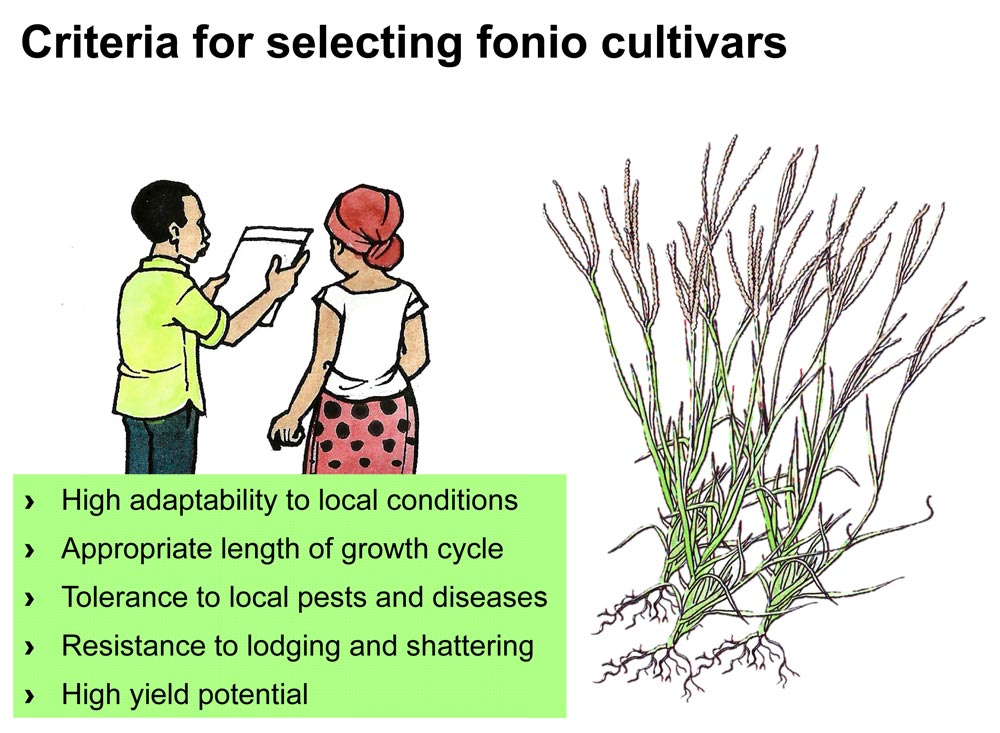Selection of suitable cultivars

For good results farmers should select the most suitable cultivars, as this determines, to some extent, the yield that can be obtained from the crop. Cultivars should be selected according to the length of the local growing period, their resistance to lodging, pests, diseases and shattering, as well as their yield potential.
In the last years, fi rst improved cultivars have been released in West African countries, including fi ve cultivars in the Benin Republic with an early to medium growing period and good yield potentials. Further breeding efforts and proper plant seed selection may result in improved stability of tillers to prevent lodging, provide reduced photoperiod-sensitivity and larger grain size.
Factors to consider when selecting suitable cultivars for cultivation include:
- Length of the growing period: Fonio plants reach maturity and are ready for harvesting from 8 weeks upwards after sowing. Ideally, the growing period of the selected cultivars must match the length of the rainy season. Usually cultivars with a short to medium growing period are preferred, as they can still perform during rainfall.
- Adaptability: Selected cultivars should not only grow well under local growing conditions, but be easy to process, also when processing is done mechanically, and satisfy consumers’ preferences.
- Resistance to lodging and shattering: Lodging is a challenge in fonio cultivation due to the fragility of the plant shoots. It therefore is imperative for farmers to grow cultivars that are resistant to lodging, in order to avoid yield losses. It is also necessary to select cultivars that are, as much as possible, resistant to shattering.
- Resistance to pests and diseases: Ideally the selected cultivars would exhibit high resistance to common pests and diseases like the leaf spot disease, rust, or birds.
Yield potential: Low yields are one of the major challenges to fonio production.
It is therefore necessary to select improved cultivars, where they are available, that have the ability to give higher yields. To fulfi ll their potential such cultivars depend on improved soil fertility and management.
Proper field establishment
Fonio is grown in traditional rain-fed farming systems in areas with annual rainfall of 700 to 1000 mm. In areas with very low rainfall the crop is grown in valleys that benefi t from run-off water. From sea level up to an altitude of 1500 metres white fonio is cultivated, while in upland regions mostly black fonio is grown.
Although considered to be quite drought resistant, fonio is not as drought resistant as pearl millet. However, the fast-maturing landraces, due to their short growing period, are suited to areas with short and unreliable rains. Fonio grows on various soil conditions including poor, shallow, sandy, degraded or acidic soils, but heavy and saline soils are less suitable.
Fonio is usually sown at the beginning of the rainy season. Instead of preparing the soil the traditional way by burning the fallow vegetation and ploughing, the remaining vegetation may be slashed and left as a mulch on the soil surface to protect it from erosion and drying out. Then reduced soil cultivation may be applied, for example by ripping the soil in rows only. Although not common, such a method may have its advantages. For germination fonio only requires a superfi cially loosened soil, because of its small seeds. Loose topsoil with a fi ne tilth provides good conditions for germination.
Sowing is commonly done by broadcasting. For this, the small seeds are best mixed with an equal quantity of sand to best spread the seed. After sowing the seeds are covered with soil by a light hoeing or brushing with tree branches.
The seed rates range from 10 to 30 kg per hectare, depending on soil fertility and growing conditions. Seed rates from 50 to 70 kg per hectare result in denser stands and reducing competition from weeds. Broadcasting can result in bunches of fonio plants, which then develop poorly.
Although not common yet in fonio production, sowing in rows provides a number of advantages: it requires less seeds, results in more uniform stands and – when sown at a row distance of 15 to 20 cm – allows mechanical weeding with a hoe or a tine or blade weeder, if the soil is not covered by dry mulch.
Email: Editor@agricinafrica.com


Comments
Post a Comment